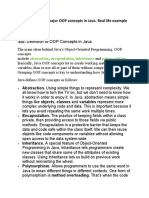0% found this document useful (0 votes)
4 views1 pageOOP Assignment Question Paper
The document outlines an assignment on Java OOP concepts, divided into three parts: short answers, coding tasks, and critical thinking. It requires definitions and examples of OOP concepts like encapsulation, inheritance, polymorphism, and abstraction, along with practical coding exercises. Additionally, it prompts critical thinking about the advantages of OOP in large-scale applications and its application in everyday software design.
Uploaded by
sarvaiyaharsh90Copyright
© © All Rights Reserved
We take content rights seriously. If you suspect this is your content, claim it here.
Available Formats
Download as PDF, TXT or read online on Scribd
0% found this document useful (0 votes)
4 views1 pageOOP Assignment Question Paper
The document outlines an assignment on Java OOP concepts, divided into three parts: short answers, coding tasks, and critical thinking. It requires definitions and examples of OOP concepts like encapsulation, inheritance, polymorphism, and abstraction, along with practical coding exercises. Additionally, it prompts critical thinking about the advantages of OOP in large-scale applications and its application in everyday software design.
Uploaded by
sarvaiyaharsh90Copyright
© © All Rights Reserved
We take content rights seriously. If you suspect this is your content, claim it here.
Available Formats
Download as PDF, TXT or read online on Scribd
/ 1






















































